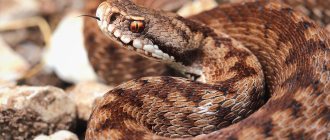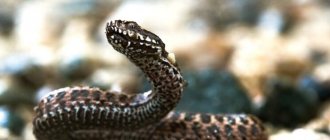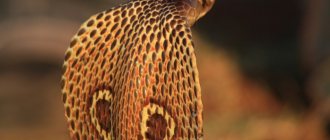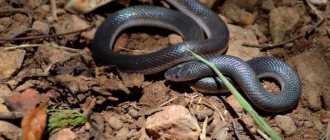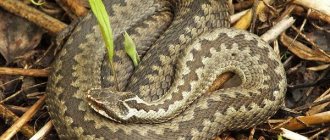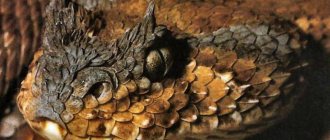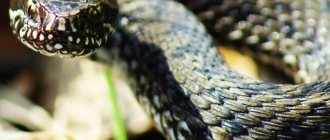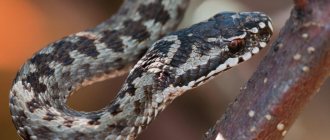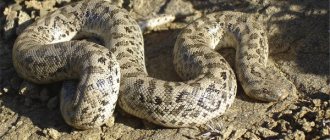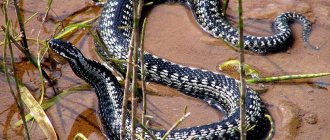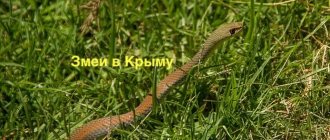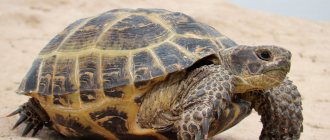558
A viper is a poisonous snake that belongs to the kingdom animals, phylum chordates, class reptiles, order squamate, family viperidae (lat. Viperidae).
The origin of the word “viper” goes back to ancient times, when the word “viper” literally meant “disgusting animal.”
Viper - photo and description. Characteristics and structure of the snake.
Most vipers have a short, thick body. The body length of a viper can reach 2-3 meters. The length of the smallest snakes does not exceed 30 cm. The weight of a large viper is about 15-17 kg.
All species of vipers are characterized by a flattened, rounded-triangular shape of the skull with noticeably prominent temporal protrusions and a blunt snout. In some species, at the tip of the muzzle, between the nostrils, single or paired formations grow - modified scales. Some species of the viper family have similar projections above their eyes, giving the viper a horned appearance.
The viper's eyes are small, with vertical pupils that can contract or dilate to fill the entire eye. Thanks to this feature, vipers have excellent vision both day and night. Above the eyes there is a scaly ridge, especially developed in some species, which gives the snake a serious and angry appearance.
The skin color of a viper can be varied and consist of intricate designs and patterns. But the color of the viper in any case depends on its habitat and is a good camouflage against the background of the surrounding landscape.
The color of the common viper consists of light brown and dark brown tones
The rough tree viper has green skin and almost does not stand out against the background of green foliage of trees.
The sand-colored skin of a horned viper is an excellent camouflage for a sand-dwelling snake.
All representatives of the viper family have a pair of well-developed fangs, hollow inside, adapted for secreting poison, which is formed in the poisonous glands located behind the upper jaw of the snake. The teeth of a viper can reach 4 cm in length (like a bushmaster, for example). Each canine grows on a movable maxillary bone that can rotate back and forth like a hinge. In the closed mouth, the viper's fangs are in a folded position and covered with a special film tissue.
During an attack or defense, the snake's mouth opens at an angle of 180 degrees, the jaw rotates and the fangs protrude forward, and the left and right fangs can rotate separately from each other. When the viper's jaws close on the body of the victim, a sharp contraction of the powerful muscles surrounding the poisonous glands occurs. The viper's venom is released in a split second and is more like a blow than a bite.
The average lifespan of a viper in nature is 15 years, although some vipers live up to 30 years.
A viper attacks a frog by plunging its fangs into it
What do vipers eat in the wild?
The viper snake is a typical nocturnal predator. Of all the methods of obtaining food, it prefers to attack its prey from an ambush. The bitten animal dies from the poison in a matter of minutes, and the viper swallows the prey whole.
The viper's diet consists of small rodents, insects, amphibians and birds. Vipers happily eat forest lizards, grass and marsh frogs, voles, spindles and shrews, as well as eggs and chicks of sparrows, pipits, buntings, and warblers. Young vipers feed on beetles, locusts, and catch caterpillars, butterflies, worms, slugs and ants. Snakes from the genus of African vipers, due to their impressive body size (up to 1.8 m), in addition to the usual diet for all snakes, attack hares, porcupines, tree monkeys, as well as dwarf antelope.
Grape-headed snake
The vine sharp-headed snake can easily claim the title of the most beautiful reptile on the planet. It stands out thanks to its bright green scales and unusual head shape. This snake can often be seen in large terrariums - after all, such beauty does not deserve to be hidden.
Natural enemies of the viper.
Despite the fact that the viper is a poisonous snake, it also has enemies that even such a formidable representative of the fauna cannot cope with. The enemies of the viper in nature, first of all, include hedgehogs, which enter into an unequal battle and almost always emerge victorious. Foxes, large ferrets, badgers and even wild boars will not miss the opportunity to feast on viper meat: surprisingly, snake venom has absolutely no effect on these animals. Certain birds should definitely be considered enemies of vipers. Among them, storks, herons, owls and eagles are especially fond of diversifying their menu with a “dish” of viper.
Sandy efa
Found north of the African equator, sand ephs (Echis carinatus) are small but vicious snakes. On average, adult vipers reach a length of less than a meter. They make a “hissing” warning sound when their scales rub against each other. Snake venom is hemotoxic and very dangerous.
According to some researchers, the sand ephemeral venom is 5 times more toxic than the venom of the cobra and 16 times more toxic than the venom of the Russell's viper (one of the deadliest snakes in Asia).
Where and how do viper snakes winter?
Wintering of vipers begins in October-November. For winter “apartments”, various burrows are selected, going into the ground to a depth of 2 m, where the air temperature remains above zero. At high population densities, several hundred individuals often accumulate in one burrow. The duration of wintering depends on the area: northern species of vipers overwinter for up to 9 months a year, inhabitants of temperate latitudes crawl to the surface in March-April and immediately begin breeding.
Green python
An incredibly aesthetic creation that personifies elegance, nobility and tranquility. The unusual color of its scales allows us to consider the green python one of the most beautiful snakes on the planet. You will be surprised, but green pythons can be both black and albinos - but still, the lime ones seem to us the most beautiful.
Viper venom - consequences of a snake bite and symptoms.
The viper's venom is considered potentially dangerous to humans, and the bite of some members of the viper family can be fatal and result in death.
Nevertheless, viper venom has found its use, because it is a valuable raw material for the manufacture of medicines and even cosmetics. The poison is a cocktail of proteins, lipids, peptides, amino acids, sugar and salt of inorganic origin. Preparations obtained from viper venom are used as a painkiller for neuralgia and rheumatism, for hypertension and skin diseases, to relieve asthma attacks, for inflammatory processes and bleeding.
The viper's venom enters the human or animal body through the lymph nodes and instantly enters the blood. The consequences of a viper bite are manifested by burning pain, redness and swelling form around the wound, which disappear after 2-3 days without any serious consequences. In case of severe intoxication of the body, the following symptoms appear 15-20 minutes after a viper bite: the bitten person feels dizziness, nausea, chills, and rapid heartbeat. With increased concentrations of toxic substances, fainting, convulsions and coma occur.
Viper bite - first aid.
What to do if bitten by a viper:
- First of all, immediately after a viper bite, be sure to provide rest to the bitten organ (usually the limbs), securing it with something like a splint or, for example, simply tying your arm in a bent position with a scarf. Limit any active movements to avoid the rapid spread of viper venom throughout the body.
- A viper bite is dangerous and can be fatal to humans, so in any case, regardless of the severity of the victim’s condition, you should call an ambulance!
- By pressing your fingers at the bite site, try to slightly open the wound and suck out the poison. This can be done with your mouth, periodically spitting saliva, but the method is only permissible if there is no damage to the oral mucosa in the form of cracks, scratches or ulcers. You can try to reduce the concentration of poison in the wound with an ordinary glass glass, using it according to the principle of placing medical cups. The venom is sucked out continuously for 15-20 minutes.
- Then the viper bite site should be disinfected with any available means: cologne, vodka, alcohol, iodine, and a clean, lightly pressing bandage should be applied.
- If possible, it is advisable to take an antihistamine tablet to reduce the allergic reaction to the viper venom.
- Take as much liquid as possible - weak tea, water, but avoid coffee: this drink increases blood pressure and increases excitability.
- In case of serious injury, as first aid after a viper bite, a person is given artificial respiration and prolonged cardiac massage.
Sometimes vipers are confused with representatives of the colubrid family - snakes, snakes and copperheads, which often leads to the killing of innocent animals. You can distinguish a poisonous snake from a harmless one by a number of signs.
Boomslang
The boomslang (Dispholidus typusis) is the most venomous rear-fanged snake in the world. It lives in sub-Saharan Africa. Boomslang comes from the Afrikaans word for tree snake. Thus, it is an “arboreal” species of snake. Unlike the Gaboon Viper, the Boomslang's fangs are much shorter, but it can open its mouth as much as 180 degrees to bite.
Although deaths are rare as the species is very timid, its venom is hemotoxic and results in internal bleeding. Sexual dimorphism is especially noticeable in boomslangs: females are brown, and males are light green with black highlights.
How is it different from a viper? Similarities and differences between snakes.
The snake is a non-venomous snake; the viper is poisonous and deadly to humans. The similarity between a snake and a viper is obvious: both snakes can have a similar color and can be encountered by a person in a forest, meadow or near a pond. And yet, these reptiles have certain characteristics by which they can be distinguished:
- The appearance of the snake and the black viper differs, despite the same skin color. The common snake has 2 yellow or orange spots on its head, similar to miniature ears, while the viper does not have such markings.
- You should not focus solely on the color of snakes, since both snakes and vipers can be similar in color. For example, the color of a water snake can be olive, brown or black, with various spots. In addition, the black water snake does not have yellow markings on its head, making it easily confused with a pit viper. The color of the viper can also be olive, black or brown, with a variety of spots scattered throughout the body.
Water snake
- And yet, if you look closely at the spots, you can see the following difference between snakes: in snakes the spots on the body are arranged in a checkerboard pattern, many types of vipers have a zigzag stripe on the back, running along the entire body, and there are also spots on the sides of the body.
- Another difference between a snake and a viper is that the pupil of a viper is vertical, while in snakes it is round.
- The viper's mouth contains sharp teeth, which are clearly visible when the snake opens its mouth. Snakes have no teeth.
- Longer than a viper. The body length of the snake is usually 1-1.3 meters. The length of the viper usually varies between 60-75 cm, although there are individuals up to 3 meters long. In addition, vipers look much more well-fed.
- The tail of the viper is shortened and thick, while that of the snake is thinner and longer. In addition, in vipers the transition from the body to the tail is clearly defined.
- Vipers differ from snakes in the triangular shape of the skull with clearly defined brow ridges; snakes have an oval-ovoid skull.
- The anal shield of the viper is solid, while in the grass snake it consists of 2 scales.
- When meeting people, snakes try to retreat and hide; the viper will most likely show complete indifference or aggression if you step on this poisonous snake or simply brush against it.
- Snakes love damp habitats, so they can often be found near bodies of water, where they swim and catch frogs. Vipers feed mainly on mice, so they choose other habitats: forests, steppes, dense grass.
Are beautiful snakes dangerous?
Each snake is dangerous in its own way:
- King cobra venom can kill a person in 15 minutes. However, she does not waste it in vain and in relation to a person she often produces “idle bites,” that is, without poison. And in the end it turns out that only 10% of attacks become fatal;
- eastern green mamba, although he can kill a person, he prefers to run away from him;
- the teeth of even the largest representatives of royal striated snakes are usually small and are not capable of causing significant harm to humans. Often these individuals become completely tame over time, although this will require long-term taming of the reptile;
- As for Dominican boas , they are very friendly towards humans. This is partly due to their laziness. During the day they are usually passive or even sleep;
- garter snakes are not aggressive and are relatively easy to care for;
- tiger pythons most often they are kept in terrariums and, despite their size, do not pose a threat to humans, since they usually feed on rodents or birds and do not like to switch to other food;
- The grassy-green whipweed from the Colubridae family is considered a poisonous snake, but not dangerous to humans. The fact is that its poisonous teeth are located very deep in its mouth and can pierce the skin only if the snake moves its jaws for a long time. Only in this case is it possible to get seriously poisoned;
- rainbow boas among serpentologists they are famous for their peaceful nature. It is difficult to anger them, but in case of danger, it can begin to hiss and even bite. Although a snake is capable of dragging a person under water, in life it tries to avoid close contacts with people;
- the Texas snake is not poisonous, but is very aggressive if it senses danger, which should be taken into account by beginners who want to get such a pet;
- but tree vipers are aggressive and can rush at the intended enemy, inflicting poisonous bites. They are very sensitive to any irritants. Although due to the small amount of toxins there have been only two recorded cases of death from a rough tree viper bite, approaching them is strictly not recommended.
Did you know? When in danger, Cuban rainbow boas often curl up into a ball, their eyes turn red, and drops of blood appear in their mouths.
What is the difference between a viper and a copperhead?
- The viper is a poisonous snake, the copperhead is not poisonous.
- Many vipers have a dark-colored zigzag stripe running along their backs, while copperheads have a “scattered” pattern of specks or dark spots on their backs. But there are also black vipers that do not have stripes.
- The viper's head is triangular in shape with pronounced arches above the eyes. Copperheads have a narrow, elongated head.
- The viper's mouth contains teeth with which the snake bites its prey. Copperheads have no teeth.
- The pupil of the copperhead is round, while that of the viper is vertically slit-shaped.
- The anal shield of the copperhead consists of a pair of scales, but in the viper it is solid.
- Having noticed a person, the copperhead will hasten to hide in a shelter; the viper will either not pay attention to the person, or will begin to attack.
Rainbow boa
Even those who are not too fond of snakes cannot resist the charm of the rainbow boa constrictor - its scales shimmering in the sun look truly magnetic. This handsome man is absolutely safe for people and cannot cause them any harm. Rainbow boas are often kept in home terrariums, since the closest relative of the anaconda is not poisonous and has a calm disposition.
What is the difference between a snake and a viper?
- The mouth of a viper and snake contains teeth, but the bite of a poisonous viper is dangerous and can be fatal, and the bite of a snake, although painful, does not pose a mortal danger, since the snake does not have poisonous glands.
- In the viper, the head and body are separated by a shortened bridge that imitates the neck; in the snake, there is no cervical interception.
- The back of most vipers is either plain, black, or has a dark stripe running in a zigzag along the entire back. The color of the runner can be plain, with transverse dark spots on the back or in a mesh.
- The snake has a distinctive pattern on the top of its skull - a dark stripe between the eyes; the viper does not have such decoration.
- The viper is much shorter and looks more plump than the snake. Snakes can grow up to 1.5 meters in length, and the standard size of vipers is 60-70 cm. Only the largest vipers have a body length reaching 2 meters.
Mozambican cobra
The Mozambican spitting cobra (Naja mossambica) is perhaps the most common cobra in tropical and subtropical Africa. It is considered one of the most dangerous African snakes, second only to the Mamba. As the name suggests, the snake can spit (“spray”, perhaps even more accurately) its cytotoxic venom with great accuracy and reach (jet up to 3 m). Its bite can cause severe tissue damage, while venom in the eye can cause blurred vision or even blindness.
If necessary, it can also rise up to two-thirds of its body length. Can feign death to avoid danger.
Types of vipers - photos and descriptions.
Modern classification distinguishes 4 subfamilies of vipers:
- pit vipers, also known as rattlesnakes or rattlers (lat. Crotalinae): they are distinguished by the presence of 2 infrared pits, which are located in the recess between the eyes and nostrils;
- toad vipers (lat. Causinae): belong to the oviparous type of snakes, which is rare among all members of the family;
- Viperidae (lat. Viperinae) - the most numerous subfamily, whose representatives live even in the Arctic (common viper);
- a zemiopinae is a subfamily represented by a single genus and species - the Burmese fairy viper.
To date, science knows 292 species of vipers. Below are several varieties of these snakes:
- The common viper (lat. Vipera berus) is a relatively small representative of the family: the body length is usually in the range of 60-70 cm, although in the northern part of the range there are individuals more than 90 cm long. The weight of the viper varies from 50 to 180 grams, with females being slightly larger than males. The head is large, slightly flattened, the muzzle is rounded. The color of the common viper is quite variable and multifaceted: the color of the main background of the back can be black, light gray, yellow-brown, reddish-brown, bright copper. Most specimens have a pronounced pattern along the back in the form of a zigzag stripe. The viper's abdomen is gray, brown-gray or black, sometimes supplemented with whitish spots. The tip of the tail is often colored bright yellow, reddish or orange. This species of viper has a fairly wide habitat. The common viper lives in the forest belt of Eurasia - it is found from the territories of Great Britain and France to the western regions of Italy and eastern Korea. It feels comfortable in hot Greece, Turkey and Albania, while also penetrating the Arctic Circle - found in Lapland and in countries on the coast of the Barents Sea. On the territory of Russia, the common viper lives in Siberia, Transbaikalia and the Far East.
- The long-nosed viper (lat. Vipera ammodytes) differs from other species by a soft, sharp, scaly outgrowth at the tip of the snout, reminiscent of a snub nose. The length of the viper is 60-70 cm (sometimes 90 cm). The body color is gray, sandy or red-brown (depending on the species); a zigzag dark stripe or a series of diamond-shaped stripes runs along the back. The long-nosed viper lives on rocky landscapes from Italy, Serbia and Croatia to Turkey, Syria and Georgia.
- The steppe viper (western steppe viper) (lat. Vipera ursinii ) is a poisonous snake that lives in lowland and mountain steppes, in alpine meadows, in ravines and semi-deserts. Steppe vipers are found in the countries of southern and southeastern Europe (France, Germany, Italy, Bulgaria, Hungary, Romania, Albania), Ukraine, Kazakhstan, Russia (in the Caucasus, southern Siberia, Rostov region, Altai). The length of the viper with a tail reaches 64 cm, females are larger than males. The color of the snake is brown-gray, with a dark brown or black zigzag stripe running along the ridge. Dark spots are scattered on the sides of the body.
- The horned keffiyeh (lat. Trimeresurus cornutus, Protobothrops cornutus) stands out among its relatives with small horns located above the eyes. The body of the viper, up to 60-80 cm long, is colored creamy-light green and dotted with dark brown spots. The snake spends almost its entire life in trees and bushes, descending to the ground only to mate. The horned keffiyeh is a typical inhabitant of the south and southeast of Asia, living in China, India and Indonesia.
- Burmese fairy viper , or Chinese viper (lat. Azemiops feae) is an oviparous species, very rare among vipers. It got its name not thanks to a fairy-tale character, but in honor of the zoologist Leonardo Fea. The length of the viper is about 80 cm. Large, snake-like scutes grow on the snake’s head. The top of the body is greenish-brown, the bottom is cream, the head is most often yellow, with yellow stripes on the sides. It is found in Central Asia in the southeast of Tibet, Burma, China and Vietnam.
- The noisy viper (lat. Bitis arietans) is one of the most beautiful and most dangerous species of African vipers. The bite of a noisy viper is fatal in 4 out of 5 cases. The snake got its name from the indignant hissing it makes in case of danger. The body of the viper is disproportionately thick with a girth of up to 40 cm and a length of about 2 m. The color of the viper can be golden yellow, dark beige or red-brown. Along the body there is a pattern consisting of 2 dozen brown marks in the shape of the Latin letter U. The noisy viper lives throughout Africa (except for the equator), as well as in the southern part of the Arabian Peninsula.
- The rhinoceros viper (lat. Bitis nasicornis) is distinguished by a special decoration on its face, consisting of 2-3 vertically protruding scales. The body is thick, can reach a length of 1.2 m, and is covered with a beautiful pattern. Along the back there are blue trapezoidal patterns with a yellow border, connected by black diamonds. The sides are covered with black triangles alternating with olive-colored diamonds with a red border. The viper's head with bright blue “cheeks” is covered with black arrows with a yellow edging. Prefers to settle in the damp, swampy forests of Equatorial Africa.
- Kaisaka , or labaria (lat. Bothrops atrox) is the largest viper of the spearhead genus, growing up to 2.5 m in length. A distinctive feature of the kaisaki is the lemon-yellow color of its chin, which is why the snake is nicknamed “yellow beard.” The slender body is covered with gray or brown skin with a diamond-shaped pattern on the back. The caisaca lives throughout Central America, Argentina and the coastal islands of South America.
- The diamondback rattlesnake (lat. Crotalus adamanteus) is the record holder among rattlesnakes for the amount of “milk yield” of venom (660 mg from one snake). A large viper can grow over 2 m in length and weigh more than 15 kg. Along the back, colored in brown tones, there is a series of 24-35 black diamonds with a brilliant shine and a light yellow border. This viper lives only in the USA: from Florida to New Orleans.
- The viper, or Levantine viper (lat. Macrovipera lebetina) is the most dangerous and poisonous viper, the venom of which is second in toxicity only to that of the cobra. It belongs to the oviparous type of snakes. The body length of an adult viper can reach 2 meters, the weight of the viper is 3 kg. The body color is gray-brown, with dark spotting, subject to variability within the range. Some individuals have a black body with a purple tint. The viper is widespread in dry foothill areas, as well as on the outskirts of large cities in North-West Africa, Asia, Transcaucasia, Dagestan and Kazakhstan.
- The African pygmy viper (lat. Bitis peringueyi) is the smallest viper in the world, the body length of an adult does not exceed 20-25 cm. Due to its modest body size, it is a relatively safe species of viper that lives in the deserts of Namibia and Angola.
- Bushmaster or surukuku (lat. Lachesis muta) is the largest viper in the world, a rare species, reaching a length of 3-4 meters with a body weight of 3 to 5 kg. Inhabits tropical rainforests of South and Central America.
Green mamba
The green mamba is an unusually beautiful snake with neon green scales. It is dangerous, poisonous, and can attack a person completely unexpectedly - for this it is also called the “green devil”. This is a tree snake that prefers not to descend to the ground unless absolutely necessary - so it is not so easy to meet it on your way.
How do vipers reproduce?
Most snakes reach sexual maturity at the age of 2 years. Reproduction of viviparous viper species occurs in May. Viper eggs are formed in the womb of the female, and the young hatch there. The brood is born at the end of summer or at the very beginning of autumn. The number of viper cubs depends on the length of the female - a medium-sized viper (up to 1 m in length) usually gives birth to 8-12 cubs.
A viper gives birth in the following way: the snake wraps itself around a tree trunk and holds its tail suspended, “scattering” the young on the ground, fully formed and ready for independent existence. The length of newborn vipers is 10-12 cm. Small vipers immediately molt, and subsequently the number of moults is 1-2 times a month.
Oviparous viper species mate from April to early summer. The clutch of a medium-sized viper contains from 8 to 23 eggs, large species lay up to 38-43 eggs. Depending on the species, the incubation period lasts from 25 days to 4 months. The snake nests in safe places: burrows, under snags or in the sand.
The female warms the clutch by contracting her muscles and protects it in every possible way until the moment when the cubs begin to hatch. After this, the snakes crawl away in different directions.
Tiger python
Very massive, majestic reptiles with unusual coloring of scales. Large brown spots are randomly located on the light olive skin of the python. Tiger pythons are not poisonous and do not pose any danger to humans - therefore, quite often these snakes can be seen in terrariums.
Interesting facts about the viper:
- Schlegel's prehensile-tailed bothrops, which belongs to the viper family, hunts in a hanging position, and uses the bright tip of its tail as bait.
- Temple keffiyehs are considered sacred animals for the people of Penang Island. They are specially brought to the Snake Temple and hung on trees near their houses, considering vipers to be the guardians of the family hearth.
- Dried pit viper meat is a delicacy among Japanese and Korean gourmets; it is also used in folk healing, and is therefore highly valued.
Leave your comments and ask questions. The cat has no one to discuss this with...
Peculiarities of behavior of the spiny bush viper
Bush spiny vipers lead an arboreal lifestyle. They are adapted to living in trees. With the help of a flexible body, they easily crawl up the stems, climb inside the large calyx of the flower, and hide in the folded leaves, curled up into a ball. Reptiles are helped to climb plants by their tenacious and flexible tail and the ribbed shape of their scales, reminiscent of small leaves.
Reptiles are active at night.
Snakes prefer to rest on bushes, small trees, and reed thickets no higher than 3 meters from the surface of the ground. They often go down in search of food.
The coloration of spiny bush vipers matches the background of the environment and camouflages the reptiles, helping them remain inconspicuous in the treetops.
